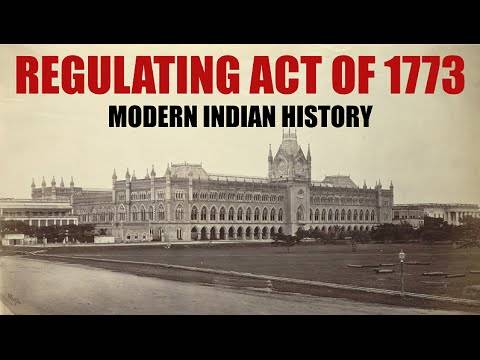Table of Contents
Regulating act of 1773 – purpose & salient features
Salient features of the Regulating Act 1773
Circumstances Prior to Regulating Act 1773
The major problem between the British parliament was to determine its relationship to the company. It was companies’ privilege and powers untouched. The second view was that the crown should take over full sovereignty of companies territorial possession in India.
Appointment of parliamentary committee
British parliament got an opportunity to Tighten on company affair and house of commons appointed to parliamentary committees.
- Select committee
- Secret committee
Salient features of the Regulating Act 1773
- Election for directors : directors of the company were elected for a period of 4 years. ¼ of them were to retire every year and retired directors were not too entitled to be elected again.
- Control over the correspondence : directors were required to place regularly all their correspondence regarding civil and military affairs.
- Appointment of governor general and council : governor General and four councillors Villa von dedenbach residencia fort Williams in Bengal. He was designated governor general of Bengal.
- Decisions by majorities present : first governor general of Bengal was Warren Hastings appointed for the term of 5 years.
- Bombay and Madras under control of governor general : presidencies of Bombay and Madras were placed under control of governor general and council while exercising their powers to make war and Peace.
- Establishment of supreme court of judicature : Sec 13 of regulating and empowered the ground to establish by charter. Supreme court of judicature Fort William in Kolkata to remove the defective state of judiciary which existed.
- Extend of governor general power :
- He has given all power to govern companies territorial acquisition in India Today venue of Bengal Bihar and Orissa and also to supervise control over the general civil and military government.
- Bombay and Madras under the control of governor general : the presidencies of Bombay and Madras were placed under the control of Superintendent governor General of council. While exercising their powers to make war and Peace.
Legislative power under Regulating Act 1173
This act granted legislative powers to companies executive authority in India. To make and issue rules, ordinances and regulations for the good order of civil government of company settlement at Fort William and other subordinate factories and places.
Charter of 1774 and supreme court at Calcutta
The regulating act 1773 superseded charter and empowered ground to establish supreme court at Calcutta. Sir Elijah Impey was first chief justice with four other judges. He drafted first civil Code. years as a barrister of England and Ireland.
The supreme court was empowered to oversee the court of collector sessions and court of request and was empowered to issue this coats rid of surgery writ of mandamus writ of error .
Critical estimate of provisions of regulating act 1773
Defeats
Many defeats came into light subsequently in 1773. There were several conflicts also.
- Governor general and councillors: the regulating act appointed governor general and four members of council and also stated the names of person the korum consist with two members only who are very well aware about the situations qualities in India. because they had already appointed but British parliament mein mistaken of sending three councillors who are new and ignorant about Indian affairs.
- The eminent necessity undefined: the governor General of presidency of Calcutta has control over the other two presidencies in Bombay and Madras.
- Conflict between judiciary and executive : The governor general and council were constituted under the same act by the crown. The judiciary and executive function at the same time act established the supreme court at Calcutta.
- Uncertainty : the framers of the Act failed to lay down the provisions dealing with the relationship between companies court and supreme court. They derived authority and jurisdiction from different sources.
Author: Pooja Pawar,
NBT Law College Nashik

